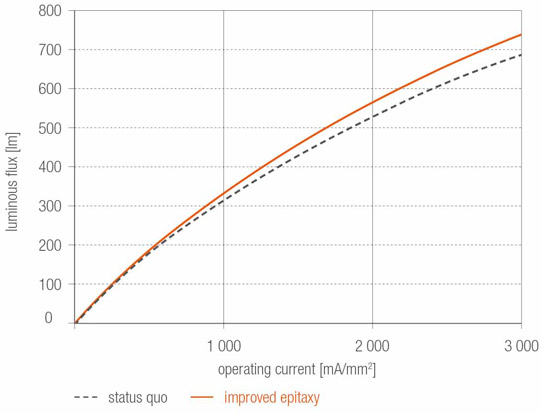- News
12 April 2016
Osram boosts luminous efficacy of white and blue high-power LEDs by 7.5%
Osram Opto Semiconductors GmbH of Regensburg, Germany has improved the luminous efficacy of its high-power light-emitting diodes (LEDs) by as much as 7.5% by reducing the unwanted effect of efficiency droop at high currents. This development was made possible by optimized epitaxial processes.
The unwanted drop in efficiency as the current density increases (i.e. droop) limits the maximum luminous efficacy of indium gallium nitride (InGaN)-based LEDs and is hence the subject of intense R&D activities worldwide. Osram Opto has now been able to reduce this effect considerably and therefore achieve a significant increase in the efficiency of the LEDs.

Picture: At 3A/mm2 the luminous efficacy of white LEDs is boosted by 7.5%.
Under laboratory conditions and at a current density of 3A/mm2, a typical luminous flux of 740lm was verified in a QFN (quad flat no lead) LED package – an improvement of about 7.5% compared with previous typical values (6200K, Cx 0.319, Cy 0.323, single-chip version LDxyz). At low current densities of 0.35A/mm2, the benefit of the optimized LEDs is still around 4%. "We have been able to reduce the droop effect considerably by extensively revising and improving the epitaxy," says project manager Dr Alexander Frey.
The new processes are being used in all Osram Opto LEDs based on UX:3 chip technology and will also have a positive impact on other high-power products. The results will now be integrated step by step in the existing product portfolio, says the firm.


